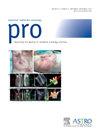Quantifying the Risk of Technology-Driven Health Disparities in Radiation Oncology
IF 3.4
3区 医学
Q2 ONCOLOGY
引用次数: 0
Abstract
Purpose
New technologies are continuously emerging in radiation oncology. Inherent technological limitations can result in health care disparities in vulnerable patient populations. These limitations must be considered for existing and new technologies in the clinic to provide equitable care.
Materials and Methods
We created a health disparity risk assessment metric inspired by failure mode and effects analysis. We provide sample patient populations and their potential associated disparities, guidelines for clinics and vendors, and example applications of the methodology.
Results
A disparity risk priority number can be calculated from the product of 3 quantifiable metrics: the percentage of patients impacted, the severity of the impact of dosimetric uncertainty or quality of the radiation plan, and the clinical dependence on the evaluated technology. The disparity risk priority number can be used to rank the risk of suboptimal care due to technical limitations when comparing technologies and to plan interventions when technology is shown to have inequitable performance in the patient population of a clinic.
Conclusions
The proposed methodology may simplify the evaluation of how new technology impacts vulnerable populations, help clinics quantify the limitations of their technological resources, and plan appropriate interventions to improve equity in radiation treatments.
量化技术驱动的差异风险。
目的:放射肿瘤学领域的新技术不断涌现。固有的技术局限性会导致弱势患者群体在医疗保健方面的差异。为了提供公平的医疗服务,必须考虑到临床中现有技术和新技术的这些局限性:我们受故障模式与影响分析(FMEA)的启发,创建了一个健康差异风险评估指标。我们提供了样本患者人群及其潜在的相关差异、诊所和供应商指南以及该方法的应用实例:结果:差异风险优先级编号(dRPN)可由三个可量化指标的乘积计算得出:受影响患者的百分比(P)、剂量测定不确定性或辐射计划质量影响的严重程度(S)以及临床对评估技术的依赖程度(C)。在比较各种技术时,dRPN 可用来排序因技术限制而导致护理效果不理想的风险,当发现某种技术在诊所的患者群体中表现不公平时,还可用来规划干预措施:建议的方法可简化对新技术如何影响弱势群体的评估,帮助诊所量化其技术资源的局限性,并规划适当的干预措施以改善放射治疗的公平性。
本文章由计算机程序翻译,如有差异,请以英文原文为准。
求助全文
约1分钟内获得全文
求助全文
来源期刊

Practical Radiation Oncology
Medicine-Radiology, Nuclear Medicine and Imaging
CiteScore
5.20
自引率
6.10%
发文量
177
审稿时长
34 days
期刊介绍:
The overarching mission of Practical Radiation Oncology is to improve the quality of radiation oncology practice. PRO''s purpose is to document the state of current practice, providing background for those in training and continuing education for practitioners, through discussion and illustration of new techniques, evaluation of current practices, and publication of case reports. PRO strives to provide its readers content that emphasizes knowledge "with a purpose." The content of PRO includes:
Original articles focusing on patient safety, quality measurement, or quality improvement initiatives
Original articles focusing on imaging, contouring, target delineation, simulation, treatment planning, immobilization, organ motion, and other practical issues
ASTRO guidelines, position papers, and consensus statements
Essays that highlight enriching personal experiences in caring for cancer patients and their families.
 求助内容:
求助内容: 应助结果提醒方式:
应助结果提醒方式:


